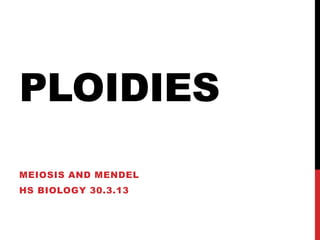Nondisjunction and Polyploidy
•Descargar como PPTX, PDF•
9 recomendaciones•15,733 vistas
A presentation on meiosis and chromosome number that focuses on errors in meiosis.
Denunciar
Compartir
Denunciar
Compartir

Recomendados
Recomendados
Más contenido relacionado
La actualidad más candente
La actualidad más candente (20)
ASSORTIVE MATING AND GENE FREQUENCY CHANGES (POPULATION GENETICS)

ASSORTIVE MATING AND GENE FREQUENCY CHANGES (POPULATION GENETICS)
Presentation on Summary of Autopolyploidy and Allopolyploidy

Presentation on Summary of Autopolyploidy and Allopolyploidy
Destacado (6)
Similar a Nondisjunction and Polyploidy
Similar a Nondisjunction and Polyploidy (20)
Pediatrics 5th year, 9th, 10th & 11th lectures (Dr. Jamal)

Pediatrics 5th year, 9th, 10th & 11th lectures (Dr. Jamal)
Changes In Number And Structure Of Chromosomes SMG

Changes In Number And Structure Of Chromosomes SMG
Activity 4 Understanding the basics of meiosisMitosis and mei.docx

Activity 4 Understanding the basics of meiosisMitosis and mei.docx
Genes, Chromosomes, and Genetic Code: Relevance and Implications

Genes, Chromosomes, and Genetic Code: Relevance and Implications
Más de Sylvia Puglisi
Más de Sylvia Puglisi (7)
Último
Último (20)
Z Score,T Score, Percential Rank and Box Plot Graph

Z Score,T Score, Percential Rank and Box Plot Graph
Seal of Good Local Governance (SGLG) 2024Final.pptx

Seal of Good Local Governance (SGLG) 2024Final.pptx
ICT Role in 21st Century Education & its Challenges.pptx

ICT Role in 21st Century Education & its Challenges.pptx
Unit-V; Pricing (Pharma Marketing Management).pptx

Unit-V; Pricing (Pharma Marketing Management).pptx
Web & Social Media Analytics Previous Year Question Paper.pdf

Web & Social Media Analytics Previous Year Question Paper.pdf
Measures of Central Tendency: Mean, Median and Mode

Measures of Central Tendency: Mean, Median and Mode
Presentation by Andreas Schleicher Tackling the School Absenteeism Crisis 30 ...

Presentation by Andreas Schleicher Tackling the School Absenteeism Crisis 30 ...
Nondisjunction and Polyploidy
- 1. PLOIDIES MEIOSIS AND MENDEL HS BIOLOGY 30.3.13
- 2. PLOIDY AND YOU DIPLOID CELLS (2N) HAPLOID CELLS (N) Mitosis produces Meiosis produces diploid cells, which haploid cells, which in humans have 46 in humans have 23 chromosomes. chromosomes.
- 3. The normal process of meiosis turns diploid body cells (2n) into haploid sex cells (n), in two steps. First, homologous chromosome pairs separate in meiosis 1. Then, sister chromatids separate in meiosis 2.
- 4. SOMETIMES, CHROMOSOMES GET STUCK DURING MEIOSIS. THIS IS CALLED CHROMOSOMAL NONDISJUNCTION
- 5. Nondisjunction leaves us with messed up gametes. Instead of having 23 chromosomes, they may have 22, 24, or even another number. Your body will often purge these germ cells before they ever get a chance to fertilize. But if they do…
- 6. (A FEW TOO MANY OR TOO FEW CHROMOSOMES) ANEUPLOIDY
- 7. DOWN SYNDROME (TRISOMY 21) Total chromosomes: 47 Either the sperm or egg cell has an extra copy of chromosome 23 due to nondisjunction during meiosis. The child can be a boy or a girl. Symptoms include: short stature, weak muscles, distinct facial features, intellectual disability, heart defects, eye conditions, hearing problems, dental problems, ADHD.
- 8. TURNER SYNDROME (MONOSOMY X) Total chromosomes: 45 Either the sperm was missing an X or Y chromosome, or the egg was missing the X chromosome and the sperm carried the Y chromosome. The baby is always female. Symptoms include: wide neck and small jaw, distinct facial features, small stature, learning disabilities, autism, lack of puberty, early menopause, infertility.
- 9. Sometimes, meiosis goes catastrophically wrong, and the gametes end up with a complete double set of chromosomes (or a complete missing set). This is called complete nondisjunction, and the body usually identifies and purges these gametes. However, if a 2n gamete goes on to fertilize another normal gamete…
- 10. (FULL SETS OF EXTRA CHROMOSOMES) POLYPLOIDY
- 11. TRIPLOID SYNDROME Total chromosomes: 69 Either the sperm or the egg has two full sets of chromosomes, leading to a triploid (3n) baby. In humans, triploid babies will either miscarry or die within the first year of life
- 12. SUCCESSFUL POLYPLOIDY Polyploidy in non-human species is not always fatal. Plants, especially, can survive and even thrive with extra sets of chromosomes. One reason for this is self-fertilization: plants can combine their own gametes, even after nondisjunction. For example, two messed up diploid gametes (2n) can combine to make a tetraploid (4n) plant, which will continue to have diploid gametes in the next generation. That doubles a plant species’ chromosomes in one generation!
- 13. Most plants we eat are either a result of (1) ancient, accidentally polyploidy or (2) intentional polyploidy due to modern agricultural techniques. Here are some relatively dramatic examples: Diploid (2n) & Tetraploid (4n) grapes
- 14. Monoploid (n) and triploid (3n) plant lines are usually sterile, and sometimes seedless.
